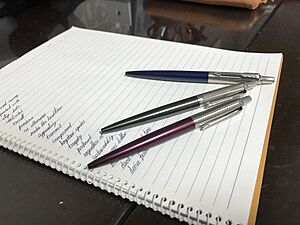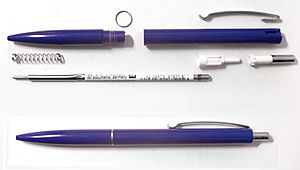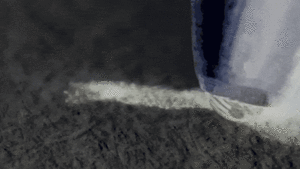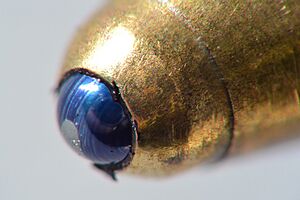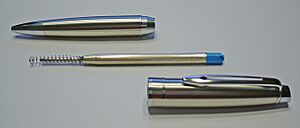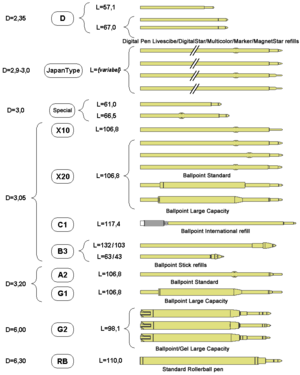Ballpoint pen facts for kids
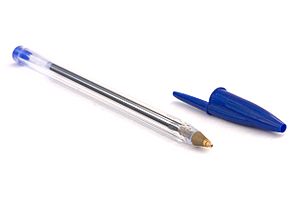
BIC Cristal ballpen
|
|
| Type | Pen |
|---|---|
| Inventor | John J. Loud |
| Inception | 1888 |
| Manufacturer |
List
|
| Available | Yes |
| Website | Lua error in Module:WikidataIB at line 168: attempt to index field 'wikibase' (a nil value). |
A ballpoint pen is a popular pen that uses a tiny metal ball at its tip. This ball rolls to spread ink onto paper. People also call it a biro in some places, or a ball pen in others. The small ball is usually made of steel, brass, or tungsten carbide. Ballpoint pens were invented to be cleaner and work better than older pens like fountain pens. Today, they are the most used writing tool in the world. Millions are made and sold every day. They are even used in art and graphic design, inspiring a special type of artwork.
Contents
The Story of Ballpoint Pens
Early Ideas and Inventions
People first thought about using a "ball point" in a pen way back in the late 1800s. The idea was to have a tiny ball at the end of a tube of ink. This ball would let ink out but stop it from falling out or drying up.
The very first patent for a ballpoint pen was given on October 30, 1888. It went to John J. Loud. He wanted a pen that could write on rough things like wood or thick paper. Regular fountain pens couldn't do this. Loud's pen had a small steel ball that spun in a holder. It worked for marking leather, but it wasn't good for writing letters. So, his idea didn't become a popular product, and the patent eventually ended.
Making the reliable ballpoint pens we use today took a lot of trying and new science. Many early pens didn't work well. Sometimes the ink wouldn't come out, or it would leak and make a mess. Inventors had to figure out how to make the ink flow just right.
Bíró's Big Breakthrough
László Bíró was a Hungarian newspaper editor. He got tired of refilling his fountain pens and cleaning up smudges. He noticed that newspaper ink dried very fast. So, he decided to make a pen that used similar quick-drying ink. Bíró asked his brother György, who was a dentist and knew about chemistry, for help. Together, they created a thicker ink for their new pen design.
Bíró's new pen used this thick ink with a special ball-and-socket system. This allowed the ink to flow smoothly without drying inside the pen. He got a British patent for his invention on June 15, 1938.
In 1941, the Bíró brothers moved to Argentina. There, they started "Bíró Pens of Argentina" and got a new patent in 1943. Their pen was called the "Birome" in Argentina, combining Bíró and Meyne (a friend's name). This is still what ballpoint pens are called there. The British Royal Air Force even used these pens. They worked better than fountain pens in airplanes, where fountain pens often leaked.
Ballpoint Pens Become Popular
After World War II, many companies wanted to make their own ballpoint pens. In 1945, an American businessman named Milton Reynolds saw Bíró's pen in Argentina. He quickly brought the idea to the United States. Reynolds made some changes to the design and got his own patent.
On October 29, 1945, Reynolds launched his "Reynolds Rocket" pen in New York City. It cost about $12.50, which was a lot of money back then! But it was a huge success. Thousands of pens sold in just one week. However, these early pens didn't always work as well as people hoped. Sales dropped, and Reynolds' company eventually closed.
In the 1950s, new brands appeared. Paper Mate pens worked on making better ink formulas. They even advertised their pens as "banker-approved" to show they were reliable. In 1954, Parker Pens released "The Jotter." This pen had new features and used strong tungsten-carbide balls. Parker sold millions of these pens quickly.
Marcel Bich also brought ballpoint pens to America in the 1950s. He used Bíró's designs and shortened his name to Bic in 1953. Bic pens became very popular after a famous ad campaign in the 1960s. This competition made pens much cheaper for everyone.
Making Pens in China
China became a huge producer of ballpoint pens. In 2017, China made 38 billion pens each year. That was 80% of all the ballpoint pens made worldwide! However, for a long time, China had to import the tiny, super-precise tips for these pens. These special tips came from countries like Germany, Switzerland, and Japan.
This was a big challenge for China. The Ministry of Science and Technology invested money to solve this problem. In 2016, a company called Taiyuan Iron & Steel Group (TISCO) finally made the first Chinese-made ballpoint pen tip. This was a big achievement for the country. The new pens were officially announced in January 2017.
How Ballpoint Pen Inks Work
Ballpoint pen ink is usually a thick paste. It contains about 25% to 40% dye, which gives it color. These dyes are mixed with special liquids called solvents and fatty acids. Common solvents like benzyl alcohol help the ink flow smoothly and dry fast. This type of ink is also known as "oil-based ink." The fatty acids also help the ball tip glide easily when you write.
Some pens use "hybrid inks." These inks have extra lubricants for an even smoother writing feel. Thicker inks usually dry faster, but you might need to press harder to write. Hybrid inks dry quickly even though they are less thick. A larger ball in the pen will release more ink, which means it might take longer to dry.
The dyes for blue and black inks often come from special chemical compounds. For example, blue inks might use Prussian blue or Victoria blue. Red ink often uses a dye called eosin. Once the ink dries, it resists water. However, some liquids like acetone or alcohol can still smudge it.
Different Kinds of Ballpoint Pens
Ballpoint pens come in two main types: disposable and refillable. Disposable pens are thrown away when the ink runs out. Refillable pens let you replace the ink tube, including the ballpoint tip. These are often fancier pens made from better materials. Simple disposable pens usually have a cap or a button to retract the tip.
Rollerball and Hybrid Pens
Rollerball pens look like ballpoint pens but use water-based inks. These inks flow very smoothly. However, water-based inks can smudge easily if you hold the pen still. They also stay wet longer, which can be tricky for left-handed people. If the paper gets wet, the ink might run.
Some ballpoint pens use "hybrid ink." This ink is not as thick as regular ballpoint ink but thicker than rollerball ink. It dries faster than gel pens, which helps prevent smudging. These pens are great for left-handed writers. They are often called "extra smooth" because they write so easily.
Erasable Ballpoint Pens
Paper Mate first made ballpoint pens with erasable ink. The ink in these pens is like a special glue. This allows you to rub it off the paper before it dries completely. Erasable ink is much thicker than regular ink. It needs a special cartridge that pushes the ink out. This means they can even write upside-down! You can use any eraser with these pens.
Ball Sizes and Special Designs
Ballpoint pen tips have balls that range in size from 0.28 mm to 1.6 mm. The size of the ball doesn't always mean how thick the line will be. The ink type and how much pressure you use also matter. Common ball sizes are 0.5 mm (fine) and 1.0 mm (medium).
The inexpensive Bic Cristal pen is one of the most popular pens in the world. It was the first product from the Bic company. The Bic Cristal is so famous that it's even in the Museum of Modern Art (MoMA) for its great design. Its clear, hexagonal barrel looks like a pencil and lets you see the ink level. Modern Bic caps have a small hole. This is a safety feature to prevent choking if a child accidentally sucks on it.
Some pens are "multi-pens." They have several different colored ink refills in one pen. Sometimes they combine a ballpoint with a mechanical pencil. Others might have a ballpoint on one end and a touchscreen stylus on the other.
Businesses like hotels often give away ballpoint pens with their name and logo. These "advertising pens" are popular with collectors. Ballpoint pens can also be designed as fancy objects, with cases made of metal or wood.
Ballpoint Pens in Space
Many people think pens won't work in space because there's no gravity. On Earth, gravity helps pull the ink down to the tip. But in space, the tiny forces inside the ink (called capillary forces) are stronger than the lack of gravity. So, a regular ballpoint pen can actually work in space, no matter which way it's pointing! An astronaut named Pedro Duque confirmed this in 2003.
However, the Fisher Space Pen was specially designed for space. It uses a thicker ink and a pressurized ink cartridge. This pressure pushes the ink towards the tip. The Space Pen's ink cartridge is sealed, so the ink won't evaporate or leak. This allows it to write upside-down, in zero-gravity, and even underwater! Astronauts have used these special pens in outer space.
Ballpoint Pens as Art
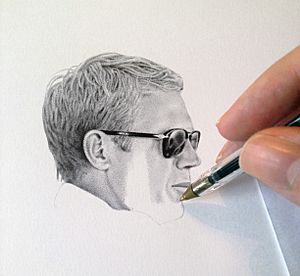
The ballpoint pen is a great tool for both professional artists and people who just like to doodle. Artists like them because they are cheap, easy to find, and simple to carry. Some artists use them with other materials, while others create entire artworks using only ballpoint pens.
Artists can create amazing effects with ballpoint pens. They use techniques like stippling (making dots) and cross-hatching (making crisscross lines) to create shadows and shapes. Ballpoint pens are perfect for artists who need very precise lines. Sometimes, ballpoint art looks so smooth it's mistaken for airbrushing or photos!
Famous artists like Andy Warhol have used ballpoint pens. Today, many contemporary artists are known for their ballpoint pen art. Korean-American artist Il Lee makes large, abstract drawings with only ballpoint pens. Since the 1980s, Lennie Mace has created imaginative ballpoint art on different surfaces like wood and denim. British artist James Mylne makes very realistic drawings, mostly with black ballpoint pens.
However, ballpoint pens have some limits for art. There aren't as many colors as paints, and the ink can fade over time in light. Also, you usually can't erase ballpoint pen marks. Sometimes the ink can "blob" or stop flowing, which artists need to be careful about.
How Ballpoint Pens Are Made
Ballpoint pens are made in huge numbers using mass production. Different parts are made separately and then put together. This includes making the ink, shaping the metal and plastic parts, and finally assembling the pen. Marcel Bich, who started Bic, helped make it possible to produce inexpensive ballpoint pens.
Even though designs vary, all ballpoint pens have similar basic parts. Making a ballpoint pen, especially the tip, requires very precise engineering. The tip includes the tiny "ball" that rolls to spread ink, a "socket" that holds the ball, and small "ink channels" that bring ink to the ball. Inside the pen is an "ink reservoir" that holds the ink. In most disposable pens, the ink is in a narrow plastic tube. Gravity helps the ink move down to the ball.
The ballpoint tip also acts as a seal. It keeps the quick-drying ink from drying out inside the reservoir. Modern ballpoint pens usually last about two years on a shelf.
Amazing Ballpoint Pen Records
- The world's largest working ballpoint pen was made by Acharya Makunuri Srinivasa in India. It is about 5.5 meters (18 feet) long and weighs over 37 kilograms (82 pounds)!
- The Bic Cristal is the most popular pen in the world. By September 2006, 100 billion of these pens had been sold. About 57 Bic Cristal pens are sold every second!
See also
 In Spanish: Bolígrafo para niños
In Spanish: Bolígrafo para niños
- Gel pen
- Retractable pen
- Rollerball pen
- Ballpoint pen knife
- List of pen types, brands and companies





